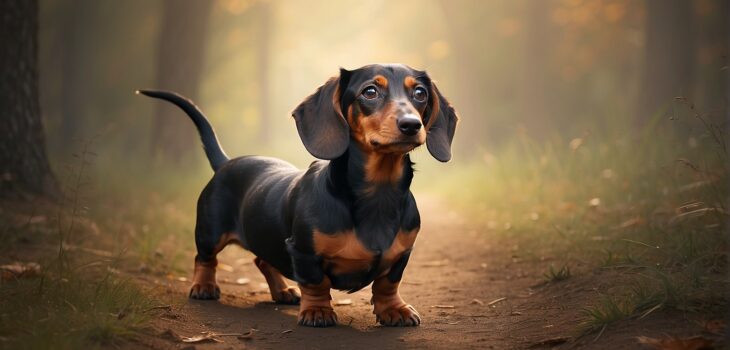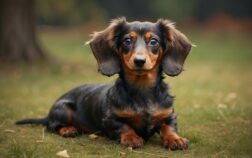Have you ever wondered why dachshunds are so long? These adorable little dogs have captured our hearts with their lengthy bodies, but the reason behind their extraordinary length remains a mystery. Despite their short legs, dachshunds boast a unique body shape that sets them apart from other breeds. In this article, we will explore the fascinating world of dachshunds and attempt to unravel the secrets behind their elongated bodies. So, grab a cup of tea, get comfy, and prepare to be amazed by the captivating tale of the dachshunds’ extraordinary length.
Evolutionary Background
Origin of Dachshunds
Dachshunds, with their distinctive long bodies and short legs, have a fascinating evolutionary background. These adorable canines originated in Germany centuries ago. The breed’s name itself provides a clue to their origin, with “dach” meaning badger and “hund” meaning dog in German. Dachshunds were originally bred to hunt badgers and other small game, making their unique physique well-suited for their intended purpose.
Role of Natural Selection
The extraordinary length of dachshunds can be attributed to the role of natural selection. Over generations, dogs with longer bodies and shorter legs were favored by hunters since they were better able to navigate and burrow into the underground tunnels where their prey resided. This natural selection process resulted in the dachshund’s distinctive physique, adapted specifically for their hunting capabilities.
Distinctive Physique
Spinal Structure
The spinal structure of dachshunds is a true marvel of nature. Their elongated spines consist of several small vertebrae, allowing them to flex and maneuver within tight spaces. This unique spinal structure enables dachshunds to burrow efficiently into underground dens, making them highly effective hunters in their prime.

Rib Cage Adaptation
Another fascinating aspect of dachshunds’ physique lies in their rib cage adaptation. Dachshunds have an elongated rib cage that provides ample space for their internal organs. This adaptation allows them to maintain proper body function despite their long and slender bodies. Additionally, their chest is deep and narrow, providing strength and stability when they need it most.
Unique Limbs
Dachshunds are known for their short and stubby legs, which are a result of intentional breeding to suit their hunting capabilities. These limbs may seem disproportionate to their long bodies, but they are specially designed to assist dachshunds in navigating through burrows and maneuvering under dense foliage. Their front legs are strong and muscular, allowing them to efficiently dig and uncover their prey, while their hind legs provide agility and propulsion.
Purposeful Breeding
Hunting Capability
Dachshunds were initially bred for their exceptional hunting capabilities, particularly in tracking and hunting small game like badgers, rabbits, and foxes. Their elongated bodies and short legs greatly aid them in following scents and maneuvering in tight spaces. They have a keen sense of smell and remarkable endurance, making them tenacious and skilled hunters.
Burrowing Skills
Dachshunds’ unique physique also plays a vital role in their burrowing skills. Their long bodies enable them to enter and explore underground dens with ease. Coupled with their sharp claws and strong forelimbs, dachshunds have the ability to dig deep into the earth and flush out their quarry. This innate ability to burrow has made them invaluable hunting companions throughout history.

Selective Breeding
As the popularity of dachshunds grew beyond their hunting prowess, selective breeding played a significant role in shaping their appearance and temperament. Over time, breeders began to focus on conforming the breed to specific standards, emphasizing specific traits such as coat type, size, and color patterns. This selective breeding has led to the diverse range of dachshunds we see today, including long-haired, wire-haired, and smooth-coated varieties.
Popularity as Companion Dogs
While dachshunds retain their hunting instincts, they have also become beloved companion dogs. Their loyal and affectionate nature, coupled with their distinctive appearance, has charmed countless individuals worldwide. Dachshunds make excellent family pets, known for their devotion and playful personalities. Their unique physique may have been forged through hunting, but their adaptability and charm make them a delightful addition to any home.
Genetic Factors
Gene Mutations
Behind the dachshund’s extraordinary length lies a combination of gene mutations. These mutations have contributed to their elongated bodies and short legs, which have become defining characteristics of the breed. Without these specific gene mutations, the dachshund’s distinctive physique would not exist, highlighting the subtle yet pivotal role of genetics in shaping dog breeds.
Long-Back Gene
One of the critical genes responsible for determining dachshunds’ length is the “long-back” gene. This gene influences the elongation of their spines and is a major contributing factor behind their unique body shape. However, it is important to note that excessive length can pose potential health risks, as discussed further in the health considerations section.
Other Genes Affecting Length
While the long-back gene is a key factor in dachshunds’ elongation, other genes also play a role in determining their length variations. Factors such as the length of individual vertebrae, the position of joints, and overall body proportions are determined by various genetic factors. The complex interplay of these genes results in the diverse range of dachshund sizes and body types observed today.
Health Considerations
Potential Back Problems
The extraordinary length of dachshunds’ spines can unfortunately make them susceptible to certain health issues, particularly related to their backs. Dachshunds are prone to intervertebral disc disease (IVDD), which is a condition where the discs between the vertebrae can degenerate or herniate. This can lead to pain, mobility issues, and, in severe cases, paralysis. It is crucial for dachshund owners to be aware of these potential health concerns and take preventive measures to minimize the risk.
Preventive Measures
To mitigate the risk of back problems, responsible dachshund owners can take several preventive measures. Maintaining a healthy weight is crucial, as excess weight can put additional strain on their spines. Avoiding activities that place excessive stress on their backs, such as jumping from heights or engaging in rough play, is also recommended. Regular exercise, with a focus on low-impact activities, can help keep their muscles strong and supportive.
Exercise and Weight Management
Regular exercise is essential for keeping dachshunds physically and mentally stimulated. However, it is important to tailor their exercise routines to their specific needs. Short, frequent walks and controlled play sessions are ideal for maintaining their fitness without putting excessive strain on their backs. Additionally, weight management through a balanced diet and portion control can help prevent obesity, which can exacerbate back issues.
Variations in Size
Standard, Miniature, and Toy Varieties
Dachshunds come in various sizes, offering options to suit different lifestyles and preferences. The standard dachshund is the original size, typically weighing between 16 to 32 pounds and standing about 8 to 9 inches tall at the shoulder. Miniature dachshunds are smaller, weighing around 11 pounds or less, while maintaining the same distinctive features as their standard counterparts. Toy dachshunds are the smallest variety, weighing under 8 pounds. These size variations allow individuals and families to find a dachshund that fits seamlessly into their lives.
Development through Dwarfism
The smaller size variations of dachshunds can be attributed to a form of dwarfism known as achondroplasia. This genetic mutation affects their bone growth, resulting in shorter legs and a compact stature. While the long-back gene is responsible for their elongated bodies, the presence of achondroplasia genes is what gives the miniature and toy dachshunds their distinct size characteristics. These size variations have contributed to the breed’s popularity and appeal to a wide range of dog enthusiasts.
Regional Influences
Geographical Context
Dachshunds’ presence is not limited to a specific region, as their popularity has spread globally. However, their origins in Germany have undoubtedly influenced their development and traits. The German landscape, with its abundance of burrowing animals like badgers, played a crucial role in shaping the breed’s hunting abilities and the associated physique. While their hunting prowess is universally appreciated, dachshund traits may differ slightly within different regions due to variations in breeding practices and cultural influences.
Dachshunds in Different Countries
Dachshunds have gained international recognition and hold a special place in the hearts of dog lovers around the world. In the United States, they are among the most popular small dog breeds, cherished for their unique appearance and delightful personalities. Similarly, in countries like the United Kingdom, France, and Australia, dachshunds have become beloved family pets and companions. Despite regional variations, their undeniable charm and distinctive physique continue to captivate people across continents.
Cultural Significance
Dachshunds in Art and Literature
The dachshund’s extraordinary length and endearing appearance have caught the attention of artists and writers throughout history. From famous paintings to children’s books, dachshunds have made their mark in art and literature. Artists such as Pablo Picasso and David Hockney have depicted dachshunds in their artworks, capturing their unique physique and character. In literature, dachshunds have often been featured as loyal companions and memorable characters, further cementing their place in popular culture.
Symbolism and Representations
Dachshunds have also been symbolically represented in various contexts. In Germany, they are seen as national symbols, representing loyalty, courage, and determination. Their elongated bodies and burrowing abilities are often associated with perseverance and resilience. In some cultures, dachshunds are believed to bring good luck and fortune. Their symbolic significance further highlights the deep impact they have made on human society.
Famous Dachshund Owners
Throughout history, dachshunds have found themselves in the company of notable individuals from various walks of life. Famous dachshund owners include renowned figures such as Picasso, Pablo Neruda, and Marlon Brando. These individuals were captivated by the breed’s unique charm and recognized their remarkable qualities as both hunting companions and loyal friends. The fascination with dachshunds extends beyond their physical appearance, permeating into the lives of influential personalities throughout the ages.
Controversial Practices
Unethical Breeding
While responsible breeding practices have shaped dachshunds into the remarkable breed they are today, unethical breeding practices have unfortunately emerged as a concern. Some breeders prioritize physical characteristics over health and temperament, leading to an increased risk of genetic health issues. It is crucial for potential dachshund owners to do thorough research and seek reputable breeders who prioritize the well-being of their dogs rather than sacrificing their long-term health for exaggerated physical traits.
Health Issues and Length
The elongated bodies of dachshunds, while unique and iconic, can pose health risks if not carefully managed. Intervertebral disc disease (IVDD) is a common health issue that dachshunds may face due to their long spines. The risk of back problems can be exacerbated by factors such as obesity, excessive jumping, or rough play. It is essential for dachshund owners to be mindful of these risks and take appropriate measures to ensure their beloved pets lead happy and healthy lives.
Debate on Breed Standards
The debate surrounding breed standards is another controversial aspect within the dachshund community. Some argue that breed standards focusing on exaggerated features, such as extremely long bodies or overly short legs, may compromise the breed’s overall health and well-being. Others advocate for breeding standards that prioritize the working ability and health of dachshunds. Striking a balance between maintaining the breed’s unique traits and ensuring the long-term health of individual dogs remains an ongoing discussion within the dachshund community.
Appreciating Dachshunds
Charm and Character
Dachshunds have an undeniable charm and character that captivates both dog enthusiasts and casual admirers alike. Their endearing appearance, combined with their friendly and affectionate nature, makes them wonderful companions. Dachshunds possess an air of confidence and determination, traits that can be traced back to their hunting heritage. Their charming personalities make them a joy to be around and a beloved addition to any family.
Training and Temperament
Dachshunds are generally intelligent dogs with a willingness to please and learn. However, they can also exhibit a stubborn streak, which may require consistent training and positive reinforcement methods. Proper socialization from an early age is essential to ensure their natural hunting instincts are directed appropriately and do not result in any behavioral issues. With patience, consistency, and understanding, dachshunds can excel in obedience training and thrive in a loving home environment.
Role as Family Pets
Dachshunds excel as family pets due to their affectionate and loyal nature. They form strong bonds with their owners and enjoy being part of daily activities. Their adaptable size allows them to comfortably fit into both large households and apartments, making them suitable for various living situations. Dachshund owners often rave about their playful and spirited personalities, adding joy and laughter to their homes. Whether curled up on the couch or exploring the great outdoors, dachshunds bring happiness and a unique charm to their families.
In conclusion, the extraordinary length of dachshunds is a result of their evolutionary background and purposeful breeding to suit their hunting capabilities. Their distinctive physique, along with their genetic factors and regional influences, has contributed to their enduring popularity. While dachshunds’ long bodies present certain health considerations, responsible ownership and preventive measures can ensure their well-being. By appreciating their charm, training them with patience and understanding, and recognizing their role as beloved family pets, dachshunds will continue to bring joy and companionship to countless people around the world.




